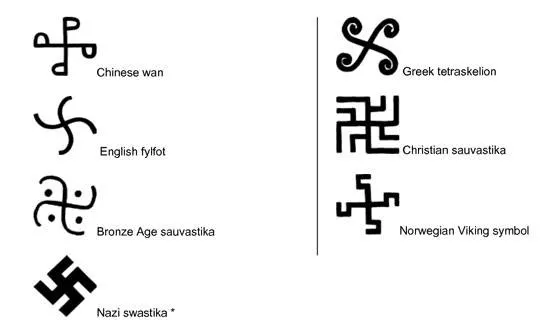Ancient symbols have a sense of mystery and awe wrapped around it – like the Swastika. The initial impression might revolve around its use by Adolf Hitler’s Nazi party, which has stigmatized its use in the Western culture.
But interestingly, it has been a sacred symbol in various ancient civilizations around the world during different times for over 3000 years, representing life, sun, fire, power, strength and good luck.
In India it remains one of the important religious symbols, mainly used in Buddhism, Hinduism and Jainism. In Jainism, the Swastika delineates the seventh saint and the four arms placed clockwise stand for the four possible places of rebirth: the animal or plant world, hell, earth, or the spirit world.
In Buddhism a swastika represents resignation, and you will often see statues of Buddha with this symbol on the chest or on the sole of the feet. Dalai Lama’s throne is decorated with four Swastikas and its even found throughout Tibet and Nepal on everyday items and as a marking denoting monasteries.
While to the Hindus, swastika symbolizes night, magic, purity, and goddess Kali. The Swastika is commonly used to mark the opening pages of account books, thresholds, doors, offerings, and its even carved on the temple facade. We used it on our wedding card as a good luck symbol and it was part of the wedding ritual as well.
The word swastika is derived from the Sanskrit svastika when literally translated from its root, means ‘well- being.’ But it has a negative connotation attached to it due to the Nazi connection. One symbol with two meanings?




Use of Swastika by the Nazis

The swastika was a symbol for the Aryans, one of the oldest race who settled in Iran and Northern India. They believed themselves to be a pure race, superior to the other surrounding cultures.
Since the Nazis regarded themselves to have Aryan roots, they used the swastika as their symbol, associated with hate, violence, death, and murder.
Adolf Hitler stated: “As National Socialists, we see our program in our flag. In red, we see the social idea of the movement; in white, the nationalistic idea; in the swastika, the mission of the struggle for the victory of the Aryan man, and, by the same token, the victory of the idea of creative work, which as such always has been and always will be anti-Semitic.”
Even in the early twentieth century, the swastika was a common decoration that often adorned cigarette cases, postcards, coins, and buildings. During World War I, the swastika was also found on the shoulder patches of the American 45th Division and on the Finnish air force until after World War II.

A universal symbol

Earliest archaeological evidence of swastika-shaped ornaments dates back to the Indus Valley Civilization of Ancient India.
Artifacts like pottery and coins from ancient Troy, dating back to 1,000 BCE, had the symbol on them!


The Celts in Ireland and Scotland frequently used to carve it on their tombstones, and the Scandanavians used it as a symbol of ‘Thor’s hammer.’ The Greeks associated the Swastika with the sun god Apollo, and it was painted on clothes, houses, ceramics and many other items.
Among various Native American tribes, the swastika carried different meanings. To the Hopi it represented the wandering Hopi clan; to the Navajo it was a symbol for a whirling log that represented a legend used in healing rituals.
But the Navajo tribe, and many others, have renounced the symbol and don’t use the swastika in their artwork again, because of its association.

For the Mayans the Swastika stood for creation and for the Incas and Aztecs it represented the four seasons due to its four arms, the centre symbolizing the sun. Swastika was also used in Mesoamerican artwork, which shows it was widely circulated.
Chinese called it, ‘WAN’ Zi, and its included as part of the Chinese script in the form of the character. It represents infinity in Tibet and China. Japanese named it ‘MAN’ Ji, and is used on Japanese maps (left-facing and horizontal), to mark the location of a Buddhist temple. The swastika, in the Japanese sense, can mean a number of positive things from strength to compassion.

In Armenia swastika is the ancient symbol of eternal light (i.e. God), while in Finland the swastika was often used in traditional folk art products or on textiles and wood. The swastika was also used by the Finnish Air Force until 1945, but is still used on air force flags.

Swastika has been used by many cultures over the centuries in different forms (clockwise or counter clockwise) and has various meanings attached to it. It’s like the universal symbol that has united the world on a common ground which is positivity, leaving aside the Nazi factor.
The swastika symbol had an extraordinary survival, in space and time, having reached the present day. Some might even argue that it remained in the collective unconscious – part of the mind that records and conserves the psychological heritage of mankind.
Resources:
Swastika, a pictorial atlas
Swastika in Russia
Swastika history




